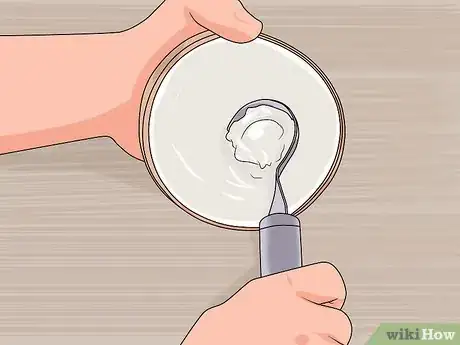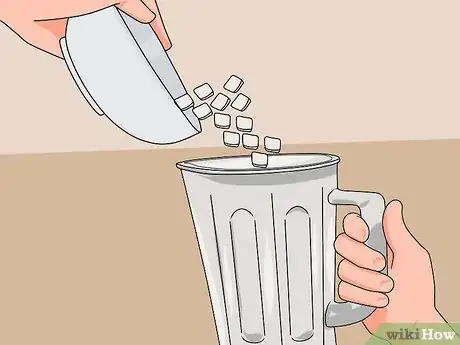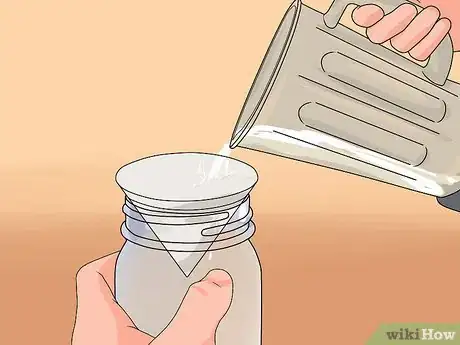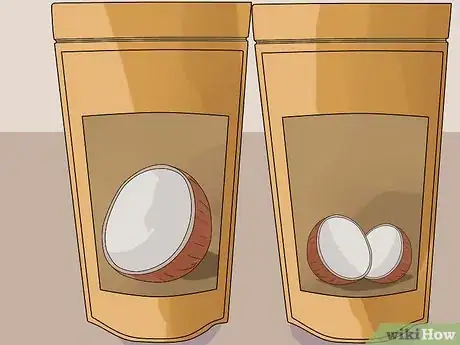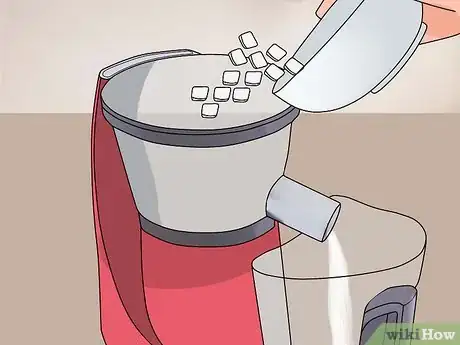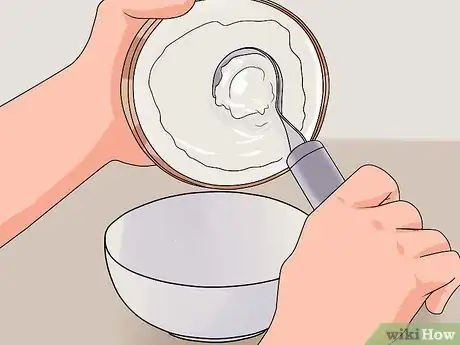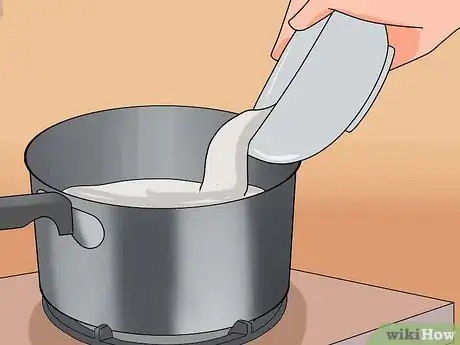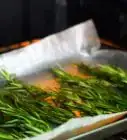wikiHow is a “wiki,” similar to Wikipedia, which means that many of our articles are co-written by multiple authors. To create this article, 44 people, some anonymous, worked to edit and improve it over time.
wikiHow marks an article as reader-approved once it receives enough positive feedback. This article received 116 testimonials and 93% of readers who voted found it helpful, earning it our reader-approved status.
This article has been viewed 1,841,078 times.
Learn more...
Coconut oil is super versatile. You can use it in your cooking, turn it into a DIY hair moisturizer, or apply it to your skin. Making your own coconut oil at home is a great way to avoid unwanted additives and preservatives, and you actually have a few different methods you can try. This article will walk you through each method step-by-step so you can whip up your own coconut oil in no time!
Steps
Using the Wet Mill Method
-
1Split a coconut with a sharp cleaver. Use a mature, brown coconut, rather than a young green one.[1]
-
2Scrape the meat of the coconut from the shell. Use a coconut scraper, sharp paring knife, or a sturdy metal spoon. Removing the meat is tricky. A butter knife is much better than a sharp paring knife. You can slide it in between the meat and the shell and 'pop' pieces off, rather than slip, and cut your hand.Advertisement
-
3Cut the coconut meat into small pieces or shred the coconut flesh with the scraper.
-
4Place the pieces into a food processor.
-
5Turn on the food processor to medium speed and blend until well shredded. Add a little water to help it blend if necessary.
-
6Filter the coconut milk. Put a coffee filter or cheesecloth over a wide-mouth jar. Pour or spoon a small amount of the coconut mixture onto the cloth. Wrap the cloth around the coconut mixture and squeeze the milk into the jar.
- Squeeze hard, to make sure you get every last drop.
- Repeat this process until all of the coconut mixture has been used.
-
7Leave the jar unattended for at least 24 hours. As it sets, the coconut milk and oil will separate and a layer of curd will appear at the top of the jar. [2]
- Refrigerate the jar so the curd hardens more quickly if you'd like.
- If you'd prefer not to refrigerate it, leave the jar in a cool room.
-
8Scoop out the curd with a spoon and discard it. The pure virgin coconut oil is left in the jar.
Using the Cold Process Method
-
1Start with dried or dehydrated coconut. You can buy dried unsweetened coconut flakes from the grocery store. Be sure the only ingredient the bag contains is coconut. If you want to start with fresh coconut meat, cut the meat into pieces and use a dehydrator to dry it out over the course of 24 hours.
- You can use the oven at its lowest temperature to dry coconut meat. Cut it into small chunks, place it on a baking sheet, and cook it at a low temperature for 8 hours, or until its completely dry.
- If you're using store-bought coconut, go for the coconut flakes, rather than shredded coconut, which tends to clog the juicer.
-
2Put the coconut in your juicer. Juice the dried coconut in small batches, since placing a lot of coconut in the juicer will cause it to clog. The juicer will remove the oil and cream from the fiber. Continue processing the coconut until all of the flakes have been run through the juicer.
-
3Process the coconut again. The juicer won't be able to extract all of the oil the first time around, so run the coconut flakes through it once more to make sure you get every last drop.
-
4Place the coconut oil in a jar and store it in a warm place. Wait 24 hours for the coconut cream to settle at the bottom of the jar. The pure coconut oil will rise to the top.
-
5Spoon the oil into a new container. Once the oil has separated from the cream and solidified, use a spoon to remove it from the first container and place it in a new container. It is now ready to use.
Boiling the Coconut
-
1Heat 4 cups of water. Place the water in a saucepan and put it on a burner. Turn the burner to medium-high and heat the water until it starts steaming.[3]
-
2Grate the meat of 2 coconuts. Use a fully developed brown coconut instead of a young green one. Open the coconut, scoop out the meat and grate it into a bowl.
-
3Blend the coconut and water. Put the grated coconut in a blender. Pour the hot water over the coconut and close the lid of the blender. Hold the lid of the blender in place and puree the coconut and water into a smooth mixture.
- Don't fill the blender more than halfway full with hot water. If your blender is on the smaller side, blend the coconut and water in two batches. Filling the blender too high may cause the lid to fly off.
- Hold the lid in place while you're blending the mixture; otherwise, it could come off while you're blending.
-
4Strain the coconut liquid. Place cheesecloth or a fine-mesh strainer over a bowl. Pour the pureed coconut over the cloth or strainer so that the coconut milk drips into the bowl. Use a spatula to push the pulp and squeeze out as much liquid as possible.
- If it's easier for you, you could pick up the cheesecloth and squeeze it over the bowl with your hands.
- To extract even more liquid, pour more hot water over the pulp and squeeze it again.
-
5Boil the coconut liquid. Place it in a saucepan on a burner and turn the heat to medium-high. Bring it to a boil and cook, stirring constantly, until the water has evaporated and the cream has separated from the oil and turned brown.
- The process of boiling the liquid until it reaches the right state could take over an hour. Be patient, and stir constantly.
- If you'd rather not boil the mixture, you can allow it to separate on its own. Place the liquid in a bowl and cover it with plastic wrap. Leave it at room temperature for 24 hours, then place it in the refrigerator so the oil solidifies and floats to the top. Strain the oil from the liquid.[4]
Community Q&A
Did you know you can get answers researched by wikiHow Staff?
Unlock staff-researched answers by supporting wikiHow
-
QuestionCan you make virgin coconut oil by fermentation?
 wikiHow Staff EditorThis answer was written by one of our trained team of researchers who validated it for accuracy and comprehensiveness.
wikiHow Staff EditorThis answer was written by one of our trained team of researchers who validated it for accuracy and comprehensiveness.
Staff Answer wikiHow Staff EditorStaff AnswerThis method uses a small amount of heat. Squeeze the milk out of some grated coconut meat and mix it with a little hot water. Cover the jug with a piece of cloth and secure it with a rubber band. Let it sit for up to 5 days so that the oil can separate from the milk. Skim off the curd on top and then scoop off the layer of oil, leaving the layer of water behind.
wikiHow Staff EditorStaff AnswerThis method uses a small amount of heat. Squeeze the milk out of some grated coconut meat and mix it with a little hot water. Cover the jug with a piece of cloth and secure it with a rubber band. Let it sit for up to 5 days so that the oil can separate from the milk. Skim off the curd on top and then scoop off the layer of oil, leaving the layer of water behind. -
QuestionIs virgin coconut oil the same as unrefined?
 wikiHow Staff EditorThis answer was written by one of our trained team of researchers who validated it for accuracy and comprehensiveness.
wikiHow Staff EditorThis answer was written by one of our trained team of researchers who validated it for accuracy and comprehensiveness.
Staff Answer wikiHow Staff EditorStaff Answer
wikiHow Staff EditorStaff Answer -
QuestionHow can I know if I've correctly processed the coconut?
 Community AnswerYou will notice that the top of the oil is thick after being refrigerated if it's been done properly.
Community AnswerYou will notice that the top of the oil is thick after being refrigerated if it's been done properly.
Things You'll Need
Wet Mill Method
- 1 fresh, mature coconut
- Cleaver
- Sharp paring knife
- Food processor
- Coffee filter or cheesecloth
- Wide-mouth glass jar
- Spoon
Cold Process Method
- Food dehydrator
- Juicer
Boiling Method
- Blender
- Fine mesh strainer
References
- ↑ https://www.jiarm.com/Dec2017/paper31692.pdf
- ↑ https://www.jiarm.com/Dec2017/paper31692.pdf
- ↑ https://www.naturallycurly.com/curlreading/diy/how-to-make-unrefined-virgin-coconut-oil-at-home
- ↑ http://desertenlightenment.wordpress.com/2012/10/16/make-your-own-virgin-cold-pressed-coconut-oil-2/
- ↑ https://www.health.harvard.edu/staying-healthy/coconut-oil
About This Article
To make virgin coconut oil, start by getting some dried coconut flakes from the grocery store. Then, run the coconut flakes through a juicer 2 times to extract all of the coconut oil from them. Put the juiced coconut in a jar and let it sit for 24 hours so the oil and cream separate. After 24 hours, scoop the separated oil out of the jar and put it in a new container. To learn how to make virgin coconut oil using a whole coconut, keep reading!

